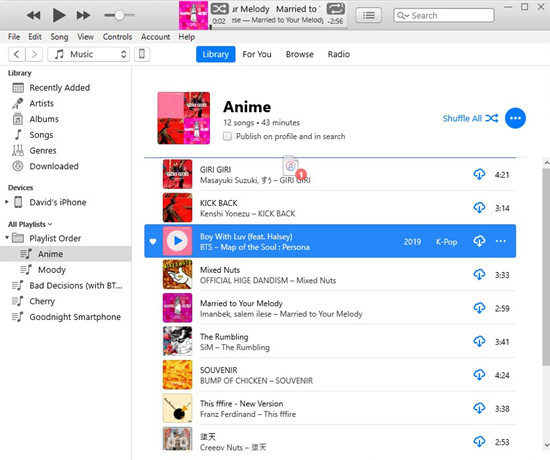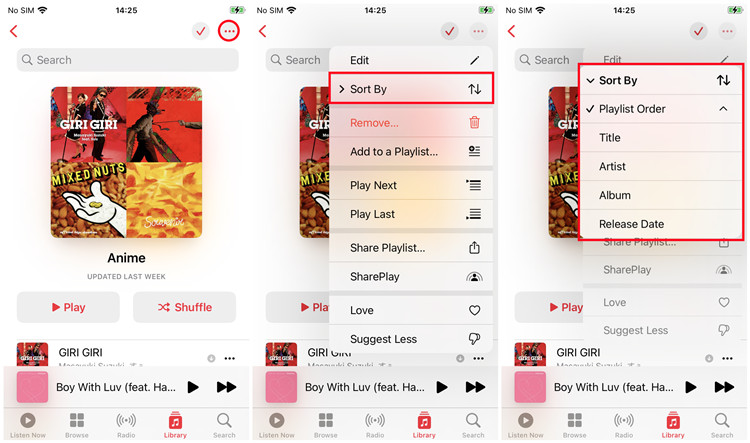Disorganization of playlist order is caused by either the synchronization settings or playback preferences of the Apple playlists. Whenever playlists are linked across the devices, any change made, for instance, when you select a particular sorting option like artist, album, or songs added recently, may affect the order of the playlist.
Also, such settings for shuffle remain useful in that they can scramble the playback temporarily but do not alter the list. An order is kept if the playlist is manually rearranged, shuffle is turned off, and you make sure settings required are saved. To achieve synced stability, do not play frequent sorts on change with multiple devices.
Why does apple Apple Music playlist order keep changing after? Mac's true component list for the Music application on iOS 18 and iPadOS 18 might feature just a single update, yet there's considerably more occurring on a deeper level than that. Whether you buy into Apple Music, the most recent form brings unlikely treasures that improve your up-next line, playlists, and, by and large, experience.
Read Also: Everything You Need to Know about Apple Homepod vs Alexa
Right away, the new elements and changes could appear to be unpretentious or even nonexistent on iOS 18 and iPadOS 18, both delivered on Sept. 16; however, a more intensive look uncovers Apple's emphasis on refining the connection point, supporting insight, and giving you more noteworthy command over your music library.
Why Does Apple Music Playlist Order Keep Changing After?

Whether you're hoping to plunge further into your assortment or find new tracks effortlessly, Mac Music's most recent cycle on iPhone and iPad has something for everybody. Peruse on as we unload what's happening and why it is important to you. In this blog, to know more about the guide on why the Apple Music playlist order keeps changing after?
1. There Are Larger Buttons in the Queue
The iOS 18 update carries new life to the line UI, and perhaps the most recognizable change gives you bigger Mix, Rehash, and Autoplay buttons. Rather than being concealed aside, they fill the entire width of the screen. This change doesn't make a difference to iPadOS 18, where the Mix and Rehash buttons stay in the player controls with Autoplay still in the upper right of the line.
2. You Get a More Organized Queue Structure
The line in the Music application has forever been somewhat aggravating since everything was constantly grouped together—playlists you're rearranging, tunes you've added physically to play straightaway, collections you've lined up, and music recordings. However, things are becoming more appealing with iOS 18 and iPadOS 18. In this blog, you will know the complete guide on how to convert Apple Music to MP3.
Previously, everything wound up in the "Playing Straightaway" line. Presently, there are isolated up-next records: "Line" and "Keep Playing." The new Keep Playing list houses everything coming up in a collection or playlist you're playing, rearranging, or rehashing, though Line shows the melodies you've physically added to play straightaway or last.
Related Post: The Best Apple Music Playlists For Finding New Music In 2024
Assuming you buy into Apple Music and have Autoplay turned on, recommended melodies to play next will in any case show up at the base in their own Autoplay segment and will begin playing when your Line and Keep Playing records have been depleted. At the point when Line and Keep Playing are both void, Autoplay will assume control over Keep Playing with an "Autoplaying comparative music" note.
3. You Can Clear Just Your Queue
In the new plan, you can likewise hit "Clear" to discard everything physically lined up without influencing the Keep Playing content. Previously, you'd need to physically play a tune or mix melodies from one more collection or playlist to clear the line, yet it would clear everything in Playing Straightaway, not simply physically added melodies, collections, and playlists.
4. Warnings Stop You from Accidentally Clearing Your Queue
On iOS 18 and iPadOS 18, at whatever point you physically play or mix an alternate collection or playlist, it will have a similar impact as in the past, starting from scratch. In this way, both Line and Keep Playing would be impacted. Nonetheless, Music currently gives you "Playing this will clear your line" prompts, clarifying that the Line rundown will become vacant, with choices to proceed or drop.
5. You Can Queue Songs from Your Queue
In one more change to your up-next line, you'll see an apple music to mp3 choice at the lower part of the Line list. Tap that to raise the picker to peruse craftsmen, collections, melodies, and the sky is the limit from there. You'll likewise see ideas beneath the library choices, for example, "Recommended Melodies" and "As of late Favorited," and a pursuit bar to chase after something explicit.
You can tap a tune's name or cover workmanship to play a review, naturally stopping anything music is playing. At the point when a review is finished, the stopped music will continue. Stir things up around town (+) button close to the substance you need to add, then, at that point, hit "Done" when you've found all that you needed. To know why does apple music playlist order keep changing after?
6. 'Play After' and 'Add to Queue' Options
Prior to iOS 18 and iPadOS 18, adding tracks, collections, and playlists to the line appeared to be basic since all that wound up in a similar Playing Next list. At the point when you tapped More you'd see choices for "Play Straightaway" and "Play Last." You could likewise swipe right on a tune, collection, or playlist from a rundown view and utilize the Play Straightaway and Play Last fastens.
Play Later," which will add the thing to the furthest limit of the collection or playlist you're paying attention to. Doing so will move the remainder of that collection or playlist from Keep Playing to Line so the new thing can be the last.

Add to Line," which will add the thing to the furthest limit of the ongoing Line list. You can in any case likewise utilize the swipe-right choices from list perspectives to "Play Straightaway" or "Add to Line," however you won't see a choice to "Play Later.
7. The 'Browse' Tab Is Now 'New'
The past "Peruse" tab in Music's route bar and sidebar menu is presently called the Apple Music to mp3. While Apple says that you "get customized new deliveries" and can "learn about pivotal turning points in music" handpicked by its editors, there doesn't appear to be a lot of distinction between the substance displayed in New versus Peruse.
Read Also: Can I Play Pandora Music on Apple Watch without Airpods?
As a general rule, the segment shows as of late delivered music, new playlists, recently refreshed playlists, diagram clinchers, moving tunes, and that's just the beginning. Do you want to know more information about the why does apple music playlist order keep changing after?
8. Listen to 'Saved Songs' from Apple TV+ InSight
Assuming you buy into Apple TV+, you gain admittance to its new Knowledge device, which records the entertainers in the ongoing scene with connections to other substance from them in the television application.
At the point when a tune is playing that is accessible on apple music to mp3, you'll see a speedy connect to add it to your Apple Music represent later tuning in. Tunes included this way end up in another playlist in the Music application called Saved Melodies.
9. Bounce Directly to Collections from Safari Features
Safari's new Features highlight, which gives page rundowns, data on individuals, and connections to Apple television, will likewise give you speedy admittance to collections on Apple Music when tunes or collections are perceived in the text. Tap the Features button in the URL bar, then, at that point, contact the Apple Music connect to open the Music application.
10. Feel Your Music Playing on Your iPhone
In some cases, we feel music in our spirit when we play a tune we love, yet with iOS 18, you can likewise feel your music in something else altogether. This is particularly valuable for individuals who are hard of hearing or almost deaf.
Music Haptics uses the Taptic Motor on the iPhone 12 and fresher models (barring the iPhone SE) to give vibrations addressing a synchronized rhythm for the ongoing tune.
This component works with Apple Music, Apple Music Traditional, and Shazam, however outsider applications can likewise join in the event that they construct support for Music Haptics. You can empower it by means of Settings » Openness » Music Haptics, which additionally records viable applications introduced on your iPhone.
Then, at that point, simply play a tune in the Music application to encounter Music Haptics. On the Now Playing view, you'll see "Music Haptics" beneath the slider when it's on, and you can tap that to stop it. You can likewise begin and prevent Music Haptics from its control in Charge Place.
Not all music in the Apple Music library is viable. While playing a melody with practically no Music Haptics accessible, it will say "Inaccessible" under the Now Playing slider. Music Haptics doesn't necessarily work when AirPlaying music or associated with specific Bluetooth speakers and earphones, so you can cripple the element rapidly in those cases to protect battery duration except if you want it for openness reasons.
11. You Can AirPlay in Spatial Sound
With iOS 18 and iPadOS 18, you might encounter better sound quality when AirPlaying from the Music application. In the updates, AirPlay presently upholds Spatial Sound with Dolby Atmos while streaming sound to your HomePod or upheld outsider sound hardware. This was at that point conceivable when AirPlaying to HomePod from an Apple television.
CarPlay additionally now upholds rotten apple choir sheet music Spatial Sound. Your viable vehicle should have multichannel sound capacities for a vivid sound encounter. Check with your vehicle producer to check whether this component works for your CarPlay framework.
12. SharePlay Over HomePod, Apple television, or Bluetooth Speakers
SharePlay has been accessible in apple music vs tidal for some time now, and last year, it added help for travels, where anybody in the vehicle could join SharePlay and control the music playback as long as the host had an Apple Music membership.
Presently, Apple Music works with SharePlay beyond vehicle trips, FaceTime, and Messages when AirPlaying music to HomePod, Apple television, or outsider Bluetooth speakers.
The host should in any case have an Apple Music membership, yet visitors joining the SharePlay will not. Visitors can utilize the playback controls, play new tunes, and that's just the beginning. Visitors can leave the SharePlay meeting effectively, and hosts can eliminate them.
